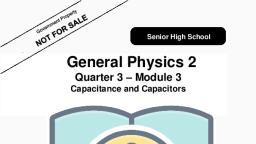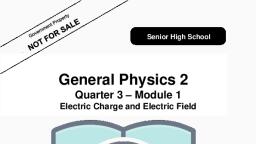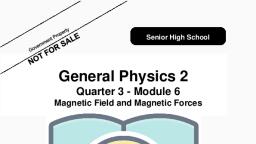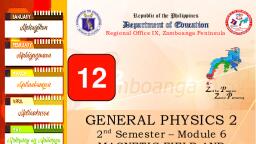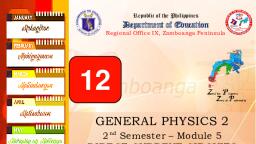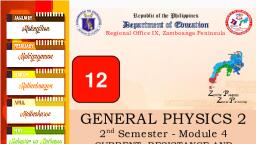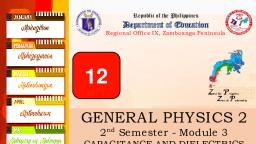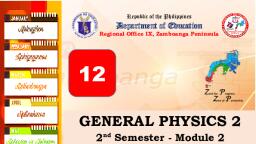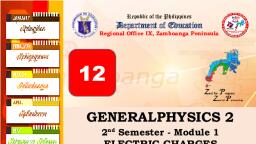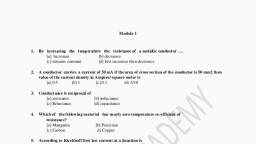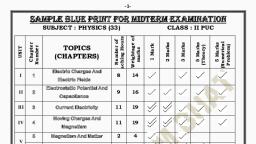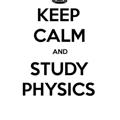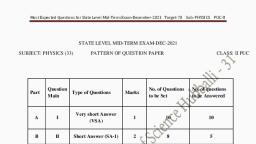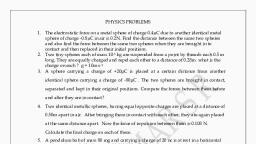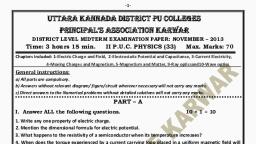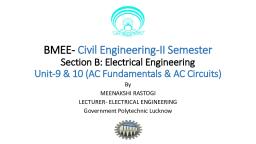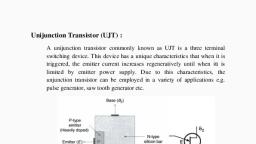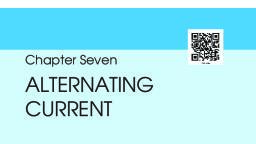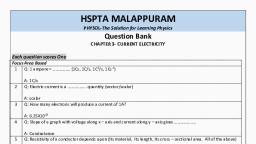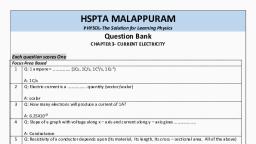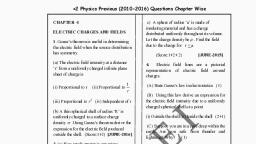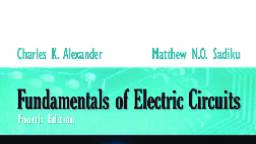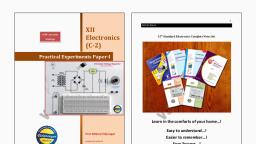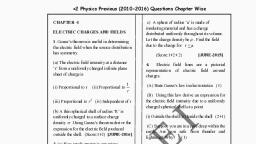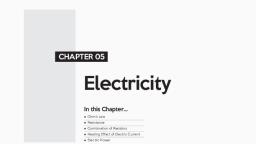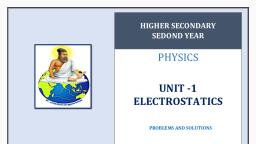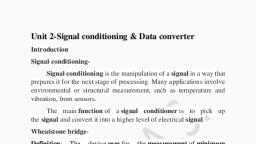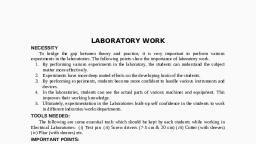Page 1 :
Senior High School, NOT, , General Physics 2, Quarter 3 - Module 5, Direct-Current Circuits, , Department of Education ● Republic of the Philippines
Page 2 : General Physics 2 - Grade 12, Alternative Delivery Mode, Quarter 3 - Module 5: Direct-Current Circuits, First Edition, 2020, Republic Act 8293, section 176 states that: No copyright shall subsist in any, work of the Government of the Philippines. However, prior approval of the government, agency or office wherein the work is created shall be necessary for exploitation of such, work for profit. Such agency or office may, among other things, impose as a condition, the payment of royalty., Borrowed materials (i.e., songs, stories, poems, pictures, photos, brand names,, trademarks, etc.) included in this book are owned by their respective copyright holders., Every effort has been exerted to locate and seek permission to use these materials, from their respective copyright owners. The publisher and authors do not represent, nor claim ownership over them., Published by the Department of Education – Division of Cagayan de Oro, Schools Division Superintendent: Dr. Cherry Mae L. Limbaco, CESO V, Development Team of the Module, Author:, , Glenmark A. Dal, , Content Evaluator: Mai A. Dal, Language Evaluator: Pinky Babiera Dela Calzada, Layout and Design:, , Arian M. Edullantes, , Management Team, Chairperson:, Cherry Mae L. Limbaco, Ph.D., CESO V, Schools Division Superintendent, Co-Chairperson:, , Rowena H. Para-on, Ph.D., Assistant Schools Division Superintendent, , Members, , Lorebina C. Carrasco, OIC-CID Chief, Jean S. Macasero, EPS - Science, Joel D. Potane, LRMS Manager, Lanie O. Signo, Librarian II, Gemma Pajayon, PDO II, , Printed in the Philippines by, Department of Education – Division of Cagayan de Oro City, Office Address:, Fr. William F. Masterson Ave., Upper Balulang, Cagayan de Oro, Telefax:, (08822)855-0048, E-mail Address:,
[email protected]
Page 3 : Senior High School, , General Physics 2, Quarter 3 - Module 5, Direct-Current Circuits, , This instructional material was collaboratively developed and reviewed, by educators from public schools. We encourage teachers and other education, stakeholders to email their feedback, comments, and recommendations to the, Department of Education at
[email protected]., We value your feedback and recommendations., , Department of Education ● Republic of the Philippines, , FAIR USE AND CONTENT DISCLAIMER: This SLM (Self Learning Module) is, for educational purposes only. Borrowed materials (i.e. songs, stories, poems,, pictures, photos, brand names, trademarks, etc.) included in these modules are, owned by their respective copyright holders. The publisher and authors do not, represent nor claim ownership over them.
Page 4 :
Table of Contents, What This Module is About ....................................................................................................................... i, What I Need to Know .................................................................................................................................. i, How to Learn from this Module............................................................................................................... ii, Icons of this Module ................................................................................................................................... ii, What I Know ................................................................................................................................................iii, , THIRD QUARTER, Lesson 1: Resistors in Series and Parallel, What Is It: Resistors in Series and Parallel ............................................................ 1, What I Have Learned ................................................................................................... 4, , Lesson 2: Kirchhoff’s Rules, What Is It: Kirchhoff’s Rules ..................................................................................... 5, What I Have Learned ................................................................................................ 8, , Lesson 3: R-C Circuits, What Is It: R-C Circuits ............................................................................................. 9, What I Have Learned: ............................................................................................... 12, Summary .................................................................................................................................................... 13, Assessment: (Post-Test) ...................................................................................................................... 14, Key to Answers......................................................................................................................................... 15, References ................................................................................................................................................. 16
Page 5 :
What This Module is About, This module demonstrates your understanding on the concepts of DirectCurrent circuits. It specifically discusses about Resistors in Series and Parallel,, Kirchhoff’s Rules, and R-C circuits., This module will help you explore the key concepts on topics that will help you, answer the questions pertaining to direct-current circuits., This module has three (3) lessons:, •, •, •, , Lesson 1 – Resistors in Series and Parallel, Lesson 2 – Kirchhoff’s Rules, Lesson 3 – R-C Circuits, , What I Need to Know, At the end of this module, you should be able to:, 1. Draw circuit diagrams with power sources (cell or battery), switches, lamps, resistors (fixed, and variable) fuses, ammeters and voltmeter STEM_GP12EM-IIIf-47;, 2. Evaluate the equivalent resistance, current, and voltage in a given network of resistors, connected in series and/or parallel STEM_GP12EM-IIIg-48;, 3. Calculate the current and voltage through and across circuit elements using Kirchhoff’s loop, and junction rules (at most 2 loops only) STEM_GP12EM-IIIg-49;, 4. Solve problems involving the calculation of currents and potential difference in circuits, consisting of batteries, resistors and capacitors. STEM_GP12EM-IIIg-51;, , i
Page 6 :
How to Learn from this Module, To achieve the objectives cited above, you are to do the following:, •, , Take your time reading the lessons carefully., , •, , Follow the directions and/or instructions in the activities and exercises diligently., , •, , Answer all the given tests and exercises., , Icons of this Module, What I Need to, , This part contains learning objectives that, , Know, , are set for you to learn as you go along the, module., , What I know, , This is an assessment as to your level of, knowledge to the subject matter at hand,, meant specifically to gauge prior related, knowledge, This part connects previous lessons with that, , What’s In, , of the current one., , What’s New, , An introduction of the new lesson through, various activities, before it will be presented, to you, , What is It, , These are discussions of the activities as a, way to deepen your discovery and understanding of the concept., , What’s More, , These are follow-up activities that are intended for you to practice further in order to, master the competencies., These are activities designed to process, what you have learned from the lessons., , What I Have, Learned, , What I can do, , These are tasks that are designed to showcase your skills and knowledge gained, and, applied into real-life concerns and situations., , ii
Page 7 :
What I Know, ., Multiple Choice. Select the letter of the best answer from among the given choices., 1. Two 50-Ω resistors are connected in series. The equivalent resistance of the combination, is, A) 25 Ω., B) 50 Ω., C) 100 Ω, D) 200 Ω, 2. Two 50-Ω resistors are connected in parallel. The equivalent resistance of the, combination is, A) 25 Ω, B) 50 Ω, C) 100 Ω., D) 200 Ω, 3. Three identical lamps are connected in series to a 6-volt battery. What is the voltage drop, across each lamp?, A) 2 volts, B) 3 volts, C) 4 volts, D) 5 volts, 4. Four identical lamps are connected in parallel to a 9-volt battery. What is the voltage drop, across each lamp?, A) 6 volts, B) 7 volts, C) 8 volts, D) 9 volts, 5. What happens to the total resistance in a network when more resistors are added to a, series circuit?, A) increases, B) decreases, C) remains the same, 6. How many 4-Ω resistors must be connected in parallel to have a total resistance of 0.8 Ω?, A) 3, B) 4, C) 5, D) 6, 7. Four resistors of resistances 3Ω, 4Ω, 5Ω, and 6Ω are connected in parallel to a 6-volt, source. What is the current through the 5-Ω resistor?, A) 1.2 A, B) 1.4 A, C) 2.2 A, D) 2.4 A, 8. In a series circuit with unequal resistances, A) The smallest R has the highest V, B) The largest R has the highest V., C) The smallest R has the most I., D) The largest R has the most I., 9. In a parallel circuit, the equivalent resistance is, A) Always greater than any individual resistance., B) Always less than any individual resistance., C) Equal to the sum of the individual resistance., D) Equal to the sum of the reciprocals of their individual resistances., 10. Two resistors, R1 = 2.00 kΩ and R2 = 3.00 kΩ, are connected in parallel and their, combination is connected in series to a fully charged, 150-µF capacitor. When the switch is, opened, the capacitor begins to discharged. What is the time constant for the discharge?, A) 0.16 s, B) 0.17 s, C) 0.18 s, D) 0.19 s, iii
Page 8 :
Lesson, , 1, , Resistors in Series and Parallel, , What is it, Most of the existing electric circuit that we see operate on more than one load. Those, circuits which have two or more loads are called multiple-load circuits. These loads may be, connected in series, in parallel, or a combination of these two connections., Resistors in Series, Figure on the right shows three resistors connected in, series to an ideal battery with emf ε. This description has, little to do with how the resistors are drawn. Rather, “in, series” means that the resistors are wired after another, and that a potential difference Vab is applied across the, two ends of the series. In the figure, the resistors are, connected one after another between a and b, and a, potential difference is maintained across a and b by the, battery. The potential differences that then exist across, the resistors in series produce identical currents I in, them., In general, when a potential difference Vab is applied across resistors connected in series, the, resistors have identical currents I. The sum of the potential differences across the resistors is, equal to the applied potential difference Vab. That is,, , Vab = IR1 + IR2 + IR3 = I ( R1 + R2 + R3 ), , Vab, = R1 + R2 + R3, I, The ratio, , 𝑉𝑎𝑏, 𝐼, , is, by definition, the equivalent resistance Req. Therefore,, , Req = R1 + R2 + R3, It is easy to generalize this for any number of resistors:, , Req = R1 + R2 + R3 +…, , 1, , (resistors in series)
Page 9 :
Resistors in Parallel, The figure shows three resistors connected in, parallel to an ideal battery. The term “in parallel”, means that the resistors are directly wired together, on the other side, and that a potential difference Vab, is applied across the pair of connected sides. Thus,, all three resistors have the same potential difference, Vab across them, producing a current through each., In general, when a potential difference Vab is applied, across resistors connected in parallel, the resistors all have that same potential difference Vab., That is,, , Vab = I1 R1 = I 2 R2 = I 3 R3, I1 =, , Vab, R1, , I2 =, , Vab, R2, , I3 =, , Vab, R3, , The total current I is, , I = I1 + I 2 + I 3, For the equivalent resistance:, , 1, 1, 1, 1, =, +, +, Req, R1 R2 R3, Again, it is easy to generalize to any number of resistors in parallel:, , 1, 1, 1, 1, +…, =, +, +, Req, R1 R2 R3, , 2, , (resistors in parallel)
Page 10 :
SAMPLE PROBLEMS:, 1. In the circuit shown below, each resistor represents a light bulb. Let R1= R2=R3=R4= 4.50Ω, and ε = 9.00V., a) Find the current in each bulb., b) Find the power dissipated in each bulb. Which bulb or bulbs glow the brightest?, Solution:, (a) Let us first determine the equivalent resistance Req of, the resistors connected in parallel., , 1, 3.0 . Taking the reciprocal gives R = 1.5 ., =, eq, Req 4.5, , The resulting circuit after combining the three resistors (which are initially connected in, parallel) is a series connection, as shown below., , 2. The power rating of a resistor is the maximum power the resistor can safely dissipate without, too great a rise in temperature and hence damage to the resistor. (a) If the power rating of, a 15-kW resistor is 5.0 W, what is the maximum allowable potential difference across the, terminals of the resistor? (b) A 9.0 kΩ resistor is to be connected across a 120 V potential, difference. What power rating is required?, Solution:, , 3
Page 11 :
What I Have Learned, Instruction: Solve the following problems neatly and completely in a one (1) whole sheet of, intermediate or yellow paper., 1. A 32.0-Ω resistor and a 20.0-Ω are connected in parallel, and the combination is applied, across a 240 V dc line., (a) What is the resistance of the parallel combination?, (b) What is the total current through the parallel combination?, (c) What is the current through each resistor?, , 2. The circuit in the figure on the right shows a network of resistors, connected in series and in parallel., (a) Determine the total resistance of the network., (b) What is the current through the 3.00-Ω?, , 3. A triangular array of resistors is shown in the figure on the, right. What current will this array draw from a 35.0V battery, having negligible internal resistance if we connect it across, a.) ab;, b.) bc and, c.) ac?, , 4. In the circuit shown on the right, the rate at which R1, dissipating electrical energy is 20.0W., (a) Find R1 and R2., (b) What is the emf of the battery?, (c) Find the current through both R2 and the 10.0-Ω, resistor., (d) Calculate the total electrical power consumption in all, the resistors and the electrical power delivered by the battery., , 4
Page 12 :
Lesson, , 2, , Kirchhoff’s Rules, , What is it, , Electric circuits that contain a number of resistors can often be analyzed by combining, individual groups of resistors in series and parallel. However, there are many circuits in which, no two resistors are in series or in parallel. To deal with such circuits, it is necessary to employ, methods other than series-parallel method. One alternative is to take advantage of Kirchhoff’s, rules which is named after their developer Gustav Kirchhoff (1824-1887)., , There are two rules, the junction rule and the loop rule. The junction rule is an application, of the law of conservation of electric charge to the electric current in a circuit. The loop rule is, an application of the principle of conservation of energy to the electric potential that exists at, various places in a circuit., , Kirchhoff’s junction rule: The algebraic sum of the currents in any junction is zero. That is,, , I = 0, , (junction rule, valid at any junction), , The Kirchhoff’s junction rule can also be stated as: the sum of the currents entering any, junction must be equal to the sum of the currents leaving that junction., , Figure 1. Kirchhoff’s junction rule states that as much current flows into a junction as flows out of it, , 5
Page 13 :
Kirchhoff’s loop rule: The algebraic sum of potential differences in any loop, including those, associated with emfs and those of resistive elements, must be equal to zero. That is, , V = 0, , (loop rule, valid for any closed loop), , Sign Conventions for the Loop Rule, , 6
Page 14 :
Sample Problem:, Find the emf’s 1 and 2 in the circuit below, and, find the potential difference of points b relative to a., Solution:, There are three (3) loops that we can make out from, the diagram. But we will only use two loops out of, the three. Let us assign loop (2) to the loop, consisting of the outside circuit elements only., , 7
Page 15 :
What I Have Learned, In the circuit shown in the figure below, find, (a) the current in resistor R;, (b) the resistance R; and, (c) the unknown emf ε., , 8
Page 16 :
Lesson, , 3, , R-C Circuits, , What is it, Many important devices incorporate circuits in which capacitors are alternately, charged and discharged. These include heart pacemakers, flashing traffic lights, automobile, turn signals, and electronic flash units. Understanding what happens in such circuits is of great, practical importance., , Charging a Capacitor, Figure (a) at the right shows a simple circuit, for charging a capacitor. A circuit such as this that, has a resistor and a capacitor in series is called an, R-C circuit. The battery is idealized to have a, constant emf Ɛ and zero internal resistance and we, neglect the resistance of all connecting conductors., We begin with the capacitor initially, uncharged (figure (a)); then at some initial time t =, 0 we close the switch, completing the circuit and, permitting current around the loop to begin charging, the capacitor., Because the capacitor is initially uncharged,, the potential difference vbc across it is zero at t = 0., At this time, from Kirchhoff’s loop rule, the voltage, vab across the resistor R is equal to the battery emf, Ɛ. The initial current, at time t = 0, through the, resistor, which we will call I0 is given by Ohm’s law:, I0 = vab/R = Ɛ/R., As the capacitor charges, its voltage vbc, increases and the potential difference vab across, the resistor decreases, corresponding to a, decrease in current. The sum of these two voltages is constant and equal to Ɛ. After a long, time, the capacitor becomes fully charged, the current decreases to zero, and the potential, difference vab across the resistor becomes zero. Then the entire battery emf Ɛ appears across, the capacitor and vbc = Ɛ., 𝑡, , 𝑡, , 𝑞 = 𝐶Ɛ (1 − 𝑒 − ⁄𝑅𝐶 ) = 𝑄𝑓 (1 − 𝑒 − ⁄𝑅𝐶 ), 𝑖=, , 𝑑𝑞, 𝑑𝑡, , Ɛ, , = 𝑒, 𝑅, , −𝑡⁄, 𝑅𝐶, , = 𝐼0 𝑒, , −𝑡⁄, 𝑅𝐶, , R-C circuit, charging capacitor, R-C circuit, charging capacitor, , 9
Page 17 :
Time Constant, After a time equal to RC, the current in the R-C circuit has decreased to 1/e (about 0.368) of, its initial value. At this time, the capacitor charge has reached (1-1/e) = 0.632 of its final value, Qf = CƐ. The product RC is therefore a measure of how quickly the capacitor charges. This, product is called the time constant or the relaxation time of the circuit., = זRC, , time constant for R-C circuit, , When זis small, the capacitor charges quickly. If the resistance is small, it’s easier for the, current to flow and the capacitor charges quickly. The unit of זis in seconds., , Discharging a Capacitor, Now suppose that after the capacitor has acquired a charge Q0,, we remove the battery from our R-C circuit and connect points a, and c to an open switch. We then close the switch and at the same, instant reset our stopwatch to t = 0; at that time, q = Q0. The, capacitor then discharges through the resistor, and its charge, eventually decreases to zero., , 𝑞 = 𝑄0 𝑒, , 𝑖=, , 𝑑𝑞, 𝑑𝑡, , −𝑡⁄, 𝑅𝐶, , =−, , 𝑄0, 𝑅𝐶, , (R-C circuit, discharging capacitor), , 𝑒, , −𝑡⁄, 𝑅𝐶, , = 𝐼0 𝑒, , −𝑡⁄, 𝑅𝐶, , (R-C circuit, discharging capacitor), , 10
Page 18 :
Sample Problem:, A resistor with resistance 10 MΩ is connected in series with a capacitor with capacitance, 1.0 µF and a battery with emf 12.0 V. Before the switch is closed at time t = 0, the capacitor is, uncharged., (a) What is the time constant?, (b) What fraction of the final charge is on the plate at time t = 46 s?, (c) What fraction of the initial current remains at t = 46 s?, Solution:, (a) = זRC = (10 x 106 Ω)(1.0 x 10-6 F) = 10 s, (b), (c), , 𝑞, 𝑄𝑓, 𝑖, 𝐼0, , =1−𝑒, , −𝑡⁄, 𝑅𝐶, , =1−𝑒, , −(46𝑠), ⁄(10𝑠), , = 0.99, , = 𝑒 −4.6 = 0.010, , 11
Page 19 :
What I Have Learned, , 1. A capacitor is charged to a potential of 12.0 V and then connected to a voltmeter having an, internal resistance of 3.40 MΩ. After a time of 4.00 s the voltmeter reads 3.0 V. What are, (a) the capacitance and (b) the time constant of the circuit?, 2. A 12.4-µF capacitor is connected through a 0.895-MΩ resistor to a constant potential, difference of 60.0 V., (a) Compute the charge on the capacitor at the following times after the connections are, mad: 0, 5.0 s, 10.0 s, 20.0 s, and 100.0 s., (b) Compute the charging currents at the same instants., , 3. In the circuit below each capacitor initially has a, charge of magnitude 3.50 nC on its plates. After the, switch S is closed, what will be the current in the, circuit at the instant that the capacitors have lost, 80.0% of their initial stored energy?, , 12
Page 20 :
Summary, Resistors in series and parallel:, When several resistors are connected in series, the equivalent resistance (or total resistance), is the sum of the values of the individual resistance in the network. The current flowing through, all the resistors is the same., , Req = R1 + R2 + R3 +…, , (resistors in series), , Ieq = I1 = I2 = I3 = …, When several resistors are connected in parallel, the reciprocal of the equivalent resistance is, equal to the sum of the reciprocals of the individual resistances. The resistors in the network, draw the same voltage from the source., , 1, 1, 1, 1, +…, =, +, +, Req, R1 R2 R3, , (resistors in parallel), , Vab = V1 = V2 = V3 = …, Kirchhoff’s Rules:, Kirchhoff’s junction rule is based on the conservation of charge. It states that the algebraic, sum of the currents into any junction must be zero., ∑𝐼 = 0, , (junction rule), , Kirchhoff’s loop rule is based on the conservation of energy and the conservative nature of, the electrostatic fields. It states that the algebraic sum of the potential differences around, any loop must be zero., ∑𝑉 = 0, , (loop rule), , R-C Circuits, When a capacitor is charged by a battery in series with a resistor, the current and capacitor, charge are not constant. The charge approaches its final value asymptotically and the, current approaches zero asymptotically., 𝑡, , 𝑡, , 𝑞 = 𝐶Ɛ (1 − 𝑒 − ⁄𝑅𝐶 ) = 𝑄𝑓 (1 − 𝑒 − ⁄𝑅𝐶 ), 𝑖=, , 𝑑𝑞, 𝑑𝑡, , Ɛ, , = 𝑒, 𝑅, , −𝑡⁄, 𝑅𝐶, , = 𝐼0 𝑒, , −𝑡⁄, 𝑅𝐶, , R-C circuit, charging capacitor, R-C circuit, charging capacitor, , When the capacitor discharges, the charge and current are given as functions of time. The, time constant is the same for charging and discharging., 𝑞 = 𝑄0 𝑒, 𝑖=, , 𝑑𝑞, 𝑑𝑡, , =−, , 𝑄0, 𝑅𝐶, , 𝑒, , −𝑡⁄, 𝑅𝐶, , −𝑡⁄, 𝑅𝐶, , (R-C circuit, discharging capacitor), = 𝐼0 𝑒, , −𝑡⁄, 𝑅𝐶, , (R-C circuit, discharging capacitor), , 13
Page 21 :
Assessment: (Post-Test), Multiple Choice. Select the letter of the best answer from among the given choices., 1. Three identical lamps are connected in series to a 12-volt battery. What is the voltage, drop across each lamp?, A) 2 volts, B) 3 volts, C) 4 volts, D) 5 volts, 2. Three 50-Ω resistors are connected in series. The equivalent resistance of the, combination is, A) 25 Ω., B) 50 Ω., C) 100 Ω, D) 150 Ω, 3. Two resistors, R1 = 2.00 kΩ and R2 = 3.00 kΩ, are connected in parallel and their combination, is connected in series to a fully charged, 150-µF capacitor. When the switch is opened, the, capacitor begins to discharged. What is the time constant for the discharge?, A) 0.16 s, B) 0.17 s, C) 0.18 s, D) 0.19 s, 4. Four 50-Ω resistors are connected in parallel. The equivalent resistance of the, combination is, A) 50 Ω, B) 25 Ω, C) 12.5 Ω., D) 6.25 Ω, 5. How many 4-Ω resistors must be connected in parallel to have a total resistance of 0.8 Ω?, A) 3, B) 4, C) 5, D) 6, 6. Four identical lamps are connected in parallel to a 6-volt battery. What is the voltage drop, across each lamp?, A) 6 volts, B) 7 volts, C) 8 volts, D) 9 volts, 7. What happens to the total resistance in a network when more resistors are added to a, series circuit?, A) increases, B) decreases, C) remains the same, 8. Four resistors of resistances 3Ω, 4Ω, 5Ω, and 6Ω are connected in parallel to a 12-volt, source. What is the current through the 5-Ω resistor?, A) 1.2 A, B) 1.4 A, C) 2.2 A, D) 2.4 A, 9. In a series circuit with unequal resistances, A) The smallest R has the highest V, B) The largest R has the highest V., C) The smallest R has the most I., D) The largest R has the most I., 10. In a parallel circuit, the equivalent resistance is, A) Always greater than any individual resistance., B) Always less than any individual resistance., C) Equal to the sum of the individual resistance., D) Equal to the sum of the reciprocals of their individual resistances., , 14
Page 23 : Reference:, Canva. Accessed December 24, 2020. https://www.canva.com/education, Sears and Zemansky’s University Physics with Modern Physics Technology Update by Hugh D., Young and Roger A. Freedman, 13th edition, pp. 944 – 977, , For inquiries and feedback, please write or call:, Department of Education – Bureau of Learning Resources (DepEd-BLR), DepEd Division of Cagayan de Oro City, Fr. William F. Masterson Ave Upper Balulang Cagayan de Oro, Telefax:, ((08822)855-0048, E-mail Address:,
[email protected], , FAIR USE AND CONTENT DISCLAIMER: This SLM (Self Learning Module) is, for educational purposes only. Borrowed materials (i.e. songs, stories, poems,, pictures, photos, brand names, trademarks, etc.) included in these modules are, owned by their respective copyright holders. The publisher and authors do not, represent nor claim ownership over them., , 16


